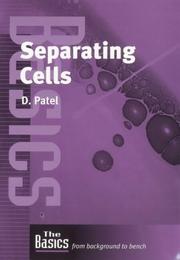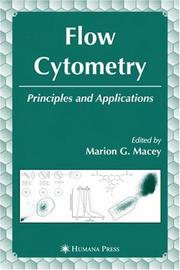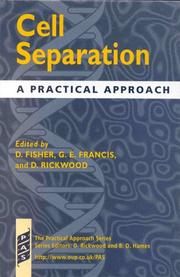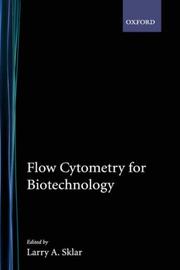| Listing 1 - 10 of 30 | << page >> |
Sort by
|

ISBN: 1135324263 1135324255 1280226382 0203015576 9786610226382 0585417466 9780585417462 9780203015575 9781135324261 9781135324216 1135324212 9781135324254 9781859961483 1859961487 1859961487 0387916121 Year: 2001 Publisher: London, England ; New York, New York : Springer,
Abstract | Keywords | Export | Availability | Bookmark
 Loading...
Loading...Choose an application
- Reference Manager
- EndNote
- RefWorks (Direct export to RefWorks)
Separating Cells: The basics provides user-friendly and practical guidance to the techniques most commonly used to separate cells. The book offers a concise overview of the fundamental principles and explains the 'what, how and why'. This title will be of considerable interest to newcomers to these techniques.

ISBN: 1280972165 9786610972166 1597454516 1588296911 Year: 2007 Publisher: Totowa, N.J. : Paisley : Humana ; Quantum [distributor],
Abstract | Keywords | Export | Availability | Bookmark
 Loading...
Loading...Choose an application
- Reference Manager
- EndNote
- RefWorks (Direct export to RefWorks)
Flow cytometry forms an integral part of both basic biological research and clinical diagnosis in pathology. This straightforward new volume provides a clear, easy-to-read, and practical manual for both clinicians and non-clinicians at all levels of their careers. The chapter topics range from basic principles to more advanced subjects, such as apoptosis and cell sorting. Throughout Flow Cytometry: Principles and Applications, well-informed expert contributors present theoretical descriptions and practical protocols on this important and complex laboratory technique and its applications. Immunologists and Hematologists in the field of pathology, as well as biological researchers working with both human and animal models will appreciate the simple, clear-cut style in which principles and protocols in this volume are presented, and will refer to this book time and time again for clear and easy-to-follow protocols.
Flow cytometry. --- Cell separation. --- Cell isolation --- Cell segregation --- Cells --- Cytometry --- Separation (Technology) --- Cell counting, Laser --- Cell separation, Laser --- Cell sorting, Laser --- Flow cytofluorometry --- Flow cytophotometry --- Laser cell counting --- Laser cell separation --- Laser cell sorting --- Separation --- Cell separation --- Cytodiagnosis --- Flow cytometry --- Cell Separation --- Flow Cytometry --- Cytologic diagnosis --- Diagnosis, Cytologic --- Diagnostic cytopathology --- Diagnosis, Laboratory --- Pathology, Cellular --- methods

ISBN: 0444527540 0080553508 9780080553504 9786611059835 1281059838 9780444527547 9781281059833 6611059830 Year: 2008 Publisher: Amsterdam ; London : Elsevier,
Abstract | Keywords | Export | Availability | Bookmark
 Loading...
Loading...Choose an application
- Reference Manager
- EndNote
- RefWorks (Direct export to RefWorks)
Cell separation is at the core of current methods in experimental biology and medicine. Its importance is illustrated by the large number of physical and biochemical principles that have been evaluated for application to cell separation. The development of cell separation methods is driven by the needs of biological and medical research, and the ever-increasing demands for sensitivity, selectivity, yield, timeliness and economy of the process. The interdisciplinary nature of research in this area and the volume of information available in research publications and conferences necessitates a ba
Magnetic properties of solids --- Fysicochemical separation methods --- Histology. Cytology --- Cell separation. --- Magnetic separation. --- Separation (Technology) --- Cell isolation --- Cell segregation --- Cells --- Cytometry --- Separation --- Cell separation --- Magnetic separation
Book
ISBN: 9535125516 9535154451 9535125508 Year: 2016 Publisher: IntechOpen
Abstract | Keywords | Export | Availability | Bookmark
 Loading...
Loading...Choose an application
- Reference Manager
- EndNote
- RefWorks (Direct export to RefWorks)
Flow cytometry - Select Topics is a collection of chapters that illustrate the constantly evolving application of flow cytometry to diverse areas of research or clinical investigations. It includes chapters on the utilization of flow cytometry in the fields of human reproduction and fertility, platelet function, apoptosis, inflammation research, leukemia immunophenotyping, and transplantation.
Flow cytometry. --- Cell counting, Laser --- Cell separation, Laser --- Cell sorting, Laser --- Flow cytofluorometry --- Flow cytophotometry --- Laser cell counting --- Laser cell separation --- Laser cell sorting --- Cytometry --- Medical genetics
Book
ISBN: 1628087102 9781628087109 9781628087093 1628087099 Year: 2013 Publisher: New York : Nova Biomedical,
Abstract | Keywords | Export | Availability | Bookmark
 Loading...
Loading...Choose an application
- Reference Manager
- EndNote
- RefWorks (Direct export to RefWorks)
Flow cytometry is a method to conduct a multiparameter analysis of cells suspended in liquid and passing through a laser beam. As cells pass through the flow chamber they are hit with the laser light beam which is scattered in different directions and recorded as forward light scatter and side light scatter. In this book, the authors discuss the principles, methodology and applications of flow cytometry. Topics include flow cytometry and epifluorescence analyses of freshwater bacterio- and virioplankton communities; application of flow cytometry in phenotyping, analysis and functional characte
Flow cytometry. --- Cell counting, Laser --- Cell separation, Laser --- Cell sorting, Laser --- Flow cytofluorometry --- Flow cytophotometry --- Laser cell counting --- Laser cell separation --- Laser cell sorting --- Cytometry
Book
ISBN: 1536146447 9781536146448 1536146439 9781536146431 Year: 2019 Publisher: New York : Nova Medicine & Health,
Abstract | Keywords | Export | Availability | Bookmark
 Loading...
Loading...Choose an application
- Reference Manager
- EndNote
- RefWorks (Direct export to RefWorks)
Flow cytometry. --- Cell counting, Laser --- Cell separation, Laser --- Cell sorting, Laser --- Flow cytofluorometry --- Flow cytophotometry --- Laser cell counting --- Laser cell separation --- Laser cell sorting --- Cytometry
Book
ISBN: 9783031108365 Year: 2022 Publisher: Cham Springer International Publishing :Imprint: Springer
Abstract | Keywords | Export | Availability | Bookmark
 Loading...
Loading...Choose an application
- Reference Manager
- EndNote
- RefWorks (Direct export to RefWorks)
Flow cytometry. --- Cell counting, Laser --- Cell separation, Laser --- Cell sorting, Laser --- Flow cytofluorometry --- Flow cytophotometry --- Laser cell counting --- Laser cell separation --- Laser cell sorting --- Cytometry --- Citometria de fluxe

ISBN: 1280375396 9786610375394 0585483477 9780585483474 9781280375392 9780191565557 0191565555 138304905X 0199635803 019963579X Year: 2023 Publisher: Oxford : Oxford University Press,
Abstract | Keywords | Export | Availability | Bookmark
 Loading...
Loading...Choose an application
- Reference Manager
- EndNote
- RefWorks (Direct export to RefWorks)
Techniques for separating cells are needed in many areas of cell biology. This text presents modern methods from the laboratories of experts in the field and includes tested, reproducible protocols, hints and tips and troubleshooting techniques.
Cell separation. --- Cell isolation --- Cell segregation --- Cells --- Cytometry --- Separation (Technology) --- Separation
Book
ISBN: 1789233453 1789233445 1838813616 Year: 2018 Publisher: IntechOpen
Abstract | Keywords | Export | Availability | Bookmark
 Loading...
Loading...Choose an application
- Reference Manager
- EndNote
- RefWorks (Direct export to RefWorks)
Flow cytometry's informative potential has been underestimated for many years because of a lack of adequate instruments, automation, reagents, and know-how to approach, integrate, and also substitute other techniques giving single information per assay. In the last decade, flow cytometers have become capable of performing high-throughput screening and high content analysis, evaluating tens of different samples' features in a single run up to 1536 formats on multiple cell populations. The introduction of imaging flow cytometry has filled the gap between flow cytometry and conventional high content imaging screening, putting flow cytometry at the center of many laboratories, which can now cover with a single instrument the vast majority of needs in research programs. The flow cytometry community is a multidisciplinary and diversified group with many different interests and fields of action. These characteristics have prompted the evolution of the techniques, applications, and instruments that allow the use of complex, sophisticated, and standardized and reliable flow cytometric assays in academic and industrial programs.
Flow cytometry. --- Cell counting, Laser --- Cell separation, Laser --- Cell sorting, Laser --- Flow cytofluorometry --- Flow cytophotometry --- Laser cell counting --- Laser cell separation --- Laser cell sorting --- Cytometry --- Medicine --- Health Sciences --- Cell Biology

ISBN: 0197561896 0190293039 1280428627 1423735021 0198034784 1602565694 9780198034780 9781423735021 9781602565692 9781280428623 9786610428625 661042862X 0195183142 0195152344 9780195152340 9780195183146 Year: 2020 Publisher: New York : Oxford University Press,
Abstract | Keywords | Export | Availability | Bookmark
 Loading...
Loading...Choose an application
- Reference Manager
- EndNote
- RefWorks (Direct export to RefWorks)
Flow cytometry is uniquely capable of the precise and quantitative molecular analysis of genomic sequence information, interactions between purified biomolecules and cellular function. Combined with automated sample handling for increased sample throughput, these features make flow cytometry a versatile platform with applications at many stages of drug discovery. Traditionally, the particles studied are cells, especially blood cells; flow cytometry is used extensively in immunology. This volume shows how flow cytometry is integrated into modern biotechnology, dealing with issues of throughput, content, sensitivity and high throughput informatics with applications in various fields.
Flow cytometry. --- Biotechnology. --- Chemical engineering --- Genetic engineering --- Cell counting, Laser --- Cell separation, Laser --- Cell sorting, Laser --- Flow cytofluorometry --- Flow cytophotometry --- Laser cell counting --- Laser cell separation --- Laser cell sorting --- Cytometry
| Listing 1 - 10 of 30 | << page >> |
Sort by
|

 Search
Search Feedback
Feedback About UniCat
About UniCat  Help
Help News
News